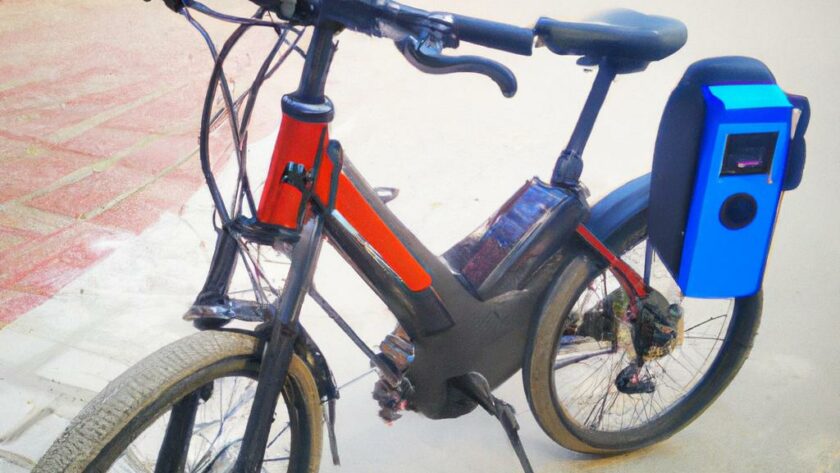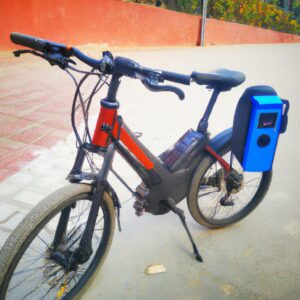Introduction to Ebikes and their increasing popularity
Ebikes, also known as electric bicycles, are becoming increasingly popular for both commuting and recreational activities. Ebikes are powered by a battery-powered motor and typically have a range of 30-60 miles before needing to recharge. With more people turning to ebikes for their travel needs, this eco-friendly option is becoming the go-to choice for short-distance transportation.
Ebikes are an attractive alternative to traditional bikes due to the assistance they provide while pedaling. This assistance can come in the form of either a throttle, pedal-assist, or a combination of both. This assistance allows riders to reach higher speeds with less physical exertion than is required on a regular bicycle, making it a great choice for those who might not be able to bike long distances without becoming exhausted.
In addition to the convenience of ebike riding, many people are choosing to go green and transition away from car transportation due to the environmental and financial benefits associated with using an electric bicycle. Reducing emissions and waste is something that makes ebikes a great choice for sensible, green-minded consumers.
The variety and affordability of ebikes also make them an appealing option for those on a budget. Different models offer different features, from lightweight frames and high-tech components to stylish accessories. Ebikes are also increasingly seen as a viable option for commuters and those who simply want to save money on transportation.
With the rise in popularity of ebikes, more people are becoming aware of the benefits and potential that accompanies using an electric bicycle. And with new technology emerging, ebikes continue to become increasingly reliable and efficient modes of transportation.
Overview of the Benefits of Riding an Ebike Compared to a Regular Bike
When thinking about biking, the first thing that usually comes to mind is a regular bicycle. But, with e-bikes quickly gaining popularity and providing numerous advantages to riders, it’s worth considering the benefits of investing in an electric bike over a traditional one.
Electric Bikes (ebikes) are powered by a battery that helps you get up hills with less effort and gives you a boost when going against the wind. This means you can ride farther and faster with less effort making it one of the more attractive features.
Riding an ebike does not require as much physical exertion as riding a regular bike, which can be beneficial for those with physical limitations or those looking for an easier ride. Ebikes take some strain off of the legs, so you are able to travel further with more energy to spare.
Ebikes also require minimal setup, so they are usually ready to go right out of the box. On top of that, they are equipped with often with advanced technology such as regenerative brakes, torque sensors, LCD displays, and more, which adds to the user experience.
The cost of ebikes have been decreasing in recent times, making them more accessible to a wider demographic. A quality ebike can be purchased for a relatively low price and they require less maintenance than regular bikes.
Overall, ebikes offer a wide range of advantages to its riders. More efficient use of energy, more comfort, less physical strain and fast setup, make ebikes a great option compared to regular bicycles.
Physical Benefits of Riding an Ebike
Riding an ebike offers many physical benefits, from improved posture and physical fitness to helping with rehabilitation from injury. Whether you use your ebike on a daily commute or just for fun on the weekends, it is important to understand these physical benefits in order to maximize their health and well-being effects.
Physical Fitness
Ebike riding has been linked to improved physical fitness, as cycling has long been recognized as one of the best forms of aerobic exercise. The power of an electric motor produces added torque, making it easier to ride up hills and hills. Additionally, cycling helps to improve cardiovascular endurance and strength, which can help reduce the risk of chronic diseases such as heart disease and diabetes.
Posture Considerations
The ergonomic design of an ebike ensures that riders benefit from improved posture. Sitting up higher makes for an easier, more comfortable ride. In addition, the correct positioning of the handlebars and saddle make it easier to maintain a straight spine as you cycle. This can have a significant impact on helping improve blood flow and preventing pain in the arms, shoulders, and back.
Rehabilitation Benefits
Ebikes provide great benefits to those undergoing rehabilitation following an injury or illness. The low-impact nature of the exercise helps those who may not be able to put strain on their joints and muscles. Traditional cycling may be too much for someone recovering from an injury, but by using an ebike, they can still enjoy the physical benefits of cycling with less stress.
Conclusion
Riding an ebike offers a wide range of physical benefits when compared to riding a regular bike. It is a low-impact exercise option that offers improved posture and physical fitness, as well as aiding in recovery from injury. Ebikes are a great way to get outside and explore the world around you.
Environmental Benefits of Ebike Riding
Riding an ebike has many environmental benefits compared to riding a regular bike. When considering the environmental impact, ebikes emit much fewer emissions than cars and can help reduce air pollution in cities. Additionally, ebikes require less energy than cars, making them an economical form of transportation.
Unlike petrol or diesel powered vehicles, ebikes convert electrical energy to mechanical energy. This means that they do not require a fuel source, producing no direct emissions or wastage. This also results in lower cost for energy consumption due to the lack of fuel costs.
Ebikes typically need less space to move and park, meaning that they can be parked in unused spaces, such as on sidewalks or tight streets. By taking up less space, ebikes can reduce traffic congestion and help improve road safety.
Finally, ebikes are often quieter than regular bikes. This means that riding an ebike is much more enjoyable, particularly in busy and residential areas where noise reduction is desirable.
Biking in general is a great way to stay healthy, but by switching to an ebike, you can also contribute to the health of our planet. Ebikes provide all the joys of cycling with the added bonus of helping to reduce emissions and wastage, as well as saving money on energy consumption.
Quality and Affordability of Electric Bicycle Options
You may have heard that electric bikes, or ebikes, are growing in popularity. The reasons are plentiful – they offer a more comfortable, efficient and convenient ride than conventional bicycles. There is also an impressive variety of different bike types and styles available. Whether you need something for commuting, leisurely rides with friends, off-road terrain or even racing, there’s sure to be an ebike that meets your needs.
The good news is that quality and affordability don’t have to be mutually exclusive when it comes to electric bicycle purchasing options. Many models on the market come with high-end components and up-to-date technology, making them both reliable and capable of reaching higher speeds than traditional bikes. Additionally, there are several cost-effective alternatives to more expensive models, meaning you don’t have to break the bank to experience the joys of ebike riding.
Innovative technologies are also making electric bicycles even better. Continuous developments in motor and battery technology mean that ebikes are becoming even more efficient and powerful than ever before. Advanced features such as pedal assist, regenerative braking, and throttle response allow riders to reap the benefits of the newest technologies without sacrificing reliability and safety on the road.
For many, electric bikes have become the preferred mode of transport. Whether you’re looking for a cost-effective option or the latest in electric biking technology, there is an ebike out there to meet your needs. With new models emerging on the market all the time, you’ll be sure to find the right bike for you at an affordable price.
Comparison of Electronic Components & their Reliability
Electric bicycles are equipped with components that give them a distinct advantage over regular bicycles. These components include everything from the battery and motor to other more sophisticated parts such as the controller, throttle and transmission. Understanding the different components and their reliability is essential when choosing an ebike.
The battery is perhaps the most important component on an ebike and one that requires careful consideration when purchasing a new model. Lithium ion batteries are the norm in electric bikes and they provide a lightweight, powerful and reliable option while being relatively easy to maintain. You can expect your battery to last up to three years with proper care and maintenance.
The motor is another key component of the electric bike and it’s important to understand its capabilities. Electric motors are typically rated in watts or amps and provide power to the bicycle as you pedal. There are a few different types of electric motors, including hub motors, mid-drive motors and rear-mounted motors, each offering its own benefits and drawbacks. Depending on your specific needs, one type may be more reliable than others.
The controller is the main hub for all the other electronic components and is responsible for controlling the speed of the motor. It’s typically powered by a single battery and is highly reliable and efficient. The more sophisticated models offer more precise control over the speed and operation of the motor.
The throttle is the hand-operated control that works in conjunction with the controller and it’s critical for precise control over the speed of the electric bike. Most throttles are highly reliable and come with a variety of features depending on the model. Some require you to press and hold the trigger while others offer a twist-grip throttle.
Finally, the transmission is the transmission system that connects the motor to the rear wheel. This component is not always included on electric bicycles but it’s essential for transferring the power to the wheel. Most ebikes feature a chain drive transmission while some use a belt or gearbox. Chain drives tend to be the most durable and reliable.
Ultimately, the electric components you choose for your ebike will depend on your individual needs and budget. The components should be carefully selected for their reliability and efficiency, as these will determine the performance of your electric bicycle.
Benefits of Regenerative Braking, Regenerative Motor Components, Throttle Response and Power Assist
Ebikes are equipped with components that provide unique advantages not available on regular bicycles. Regenerative braking, regenerative motor components, throttle response, and power assist make riding a bike more efficient and safer. Let’s take a look at the benefits of these features.
Regenerative Braking
Regenerative braking utilizes the electric motor to slow down the bike by converting kinetic energy into electrical energy. This helps to slow the bike down faster, allowing for better control over the bike. It can also help extend the range of the bike and reduce battery drain.
Regenerative Motor Components
Regenerative motor components capture the kinetic energy created by the turning of the wheel and convert that energy into electrical energy. This component is beneficial in extending the range of the bike and helps to re-charge the battery while riding uphill or while coasting.
Throttle Response
Throttle response refers to the reaction time of the motor when the throttle is engaged. Ebikes are equipped with powerful motors that offer immediate acceleration, so the bike can respond quickly to rider input. This helps to provide better control over the bike and allows riders to accelerate quickly when needed.
Power Assist
Power assist is provided by the electric motor, which increases the power output of the rider while pedaling. This assists riders with going uphill or accelerating quickly, making the ride easier and more enjoyable. This can also be beneficial when carrying heavy loads of cargo or passengers.
Ebike components like regenerative braking, regenerative motor components, throttle response, and power assist offer unique benefits to riders. These features make riding an ebike more efficient and safer, making them an attractive option for riders who are looking for an upgrade from their regular bicycle.
Extending E-Bike Battery Life & Minimizing Long-Term Costs
E-bikes are becoming increasingly popular as a reliable, cost-efficient way to travel around the city. But to get the most out of your e-bike, it is important to understand how to care for the battery and maximize its life. Regular maintenance and proper charging techniques can help you save money in the long run and get more miles out of every charge.
Here are some tips to help extend your e-bike battery life and minimize long-term costs:
- Keep your battery plugged in when not riding.When you leave your e-bike, plug the battery into a charger and leave it there until your next ride. This will keep the battery topped up and prevent it from draining completely.
- Avoid using throttle mode when possible. Throttle mode draws more power from the battery, so it is best to use pedal-assist mode when you can.
- Inspect the battery terminals periodically. Make sure the connections are clean and free from any corrosion or debris that could affect the battery’s performance.
- Reduce the weight on your e-bike. Carrying extra weight on your bike can reduce your range and require more energy from the battery. So it is best to keep your payload light or use a backpack or pannier to store any additional items.
- Use lighter power settings when possible. Most electric bikes have different power modes, which draw more or less power from the battery. Use the lowest setting necessary to conserve battery life but still get the job done.
- Charge your battery regularly. Don’t wait until the battery is completely drained before recharging. A good practice is to recharge the battery after every ride, even if it is not empty. This helps keep the battery healthy and prevents it from getting overworked.
- Store the battery in a cool, dry place.Excess heat and humidity can damage the battery cells and reduce the overall lifespan. Be sure to store the battery in a temperate, dry environment when not in use.
Taking the time to maintain and care for your e-bike battery can help extend its life and minimize long-term costs. Following the tips above can help you get more out of every ride and make sure you’re getting the most value out of your e-bike investment.
Safety Features on Ebikes and Road Rules Awareness
Safety should be a priority when riding an electric bike, as with any type of bike. Fortunately, there are now many safety features available to help keep cyclists safe while on the road. A few of the most common features are a bell or horn, lights front and rear, reflective strips, and a kickstand.
Riding an ebike is subject to the same rules and regulations as riding a regular bike, meaning riders must adhere to the local road laws and regulations. This includes wearing a helmet at all times, having your lights on in low-light conditions, following traffic signals, keeping to the designated cycling lanes and avoiding illegal maneuvers.
It is also important to be aware of other cyclists and drivers on the road and respect their space. This includes keeping a safe distance from cars, signaling before making any turns, and slowing down when approaching junctions. Additionally, be sure to control your speed appropriately when negatiating curves and bends or when braking suddenly.
To ensure a safe ride for everyone, electric bike riders should be properly trained and educated on how to safely and legally operate their bike. This includes becoming familiar with the safety features, battery specs, power settings, and any other relevant information.
Finally, it is important to regularly inspect your ebike and be aware of any potential issues that could compromise your safety. Avoid any rough terrain or steep hills that could cause your electric bike to overheat or suffer damage. By taking these precautions, you can ensure you have a safe, enjoyable ride every time you go out.
Regulatory Protection, Licensing and Insurance Requirements
Electric bicycles have certain regulatory protection, licensing, and insurance requirements in place to keep riders safe and to provide recourse in the event of an accident. It is important for anyone considering buying and riding an ebike to understand and adhere to their local laws and regulations.
In most countries, electric bicycles are considered to be a type of motorized vehicle and may require registration and insurance. Without these, you could be fined for riding in certain areas or participating in events such as races. Check with your local DMV or other regulatory authority to find out what the requirements are in your area.
Even if your country does not require registration and insurance, it is important to understand the rules and regulations that apply to electric bicycles. This means understanding where they can be ridden, how fast they can go, and any other safety or operational restrictions that may be in place. For example, some states may prohibit ebikes from being used on sidewalks while others may restrict their use on city streets.
In addition, riders should also be aware of the laws and regulations regarding wearing helmets and other protective gear, along with any age restrictions for operating an ebike. It is always a good idea to wear appropriate safety gear when riding an electric bicycle, regardless of your location and governing laws.
Understanding and following all proposed standards and regulations related to electric bicycles is essential for everyone who rides them. By doing so, you can help to prevent potential accidents, protect yourself from potential legal consequences, and ensure that everyone is riding safely and responsibly.
Best Practice Tips When Riding an Ebike
Riding an electric bicycle or ebike is a great way to get out and exercise, while being mindful of safety and avoiding any accidents. To ensure you get the most out of your ride, it’s important to follow some best practices when riding an ebike.
- Wear Protective Gear: Always wear a helmet, gloves and other protective gear when riding an ebike. This will provide extra protection in the event of a fall or collision.
- Be Aware of Traffic Rules: When riding an ebike, always remember to adhere to the same traffic rules you would if riding a regular bicycle. This includes following road signs and signals, and using appropriate hand signals when turning.
- Be Predictable: When riding on the road, always be predictable and give others plenty of time to react when you change direction. Never make sudden movements or ride between lanes without signaling.
- Avoid Distractions: Never use your phone or other devices when riding an ebike. Additionally, be aware of your surroundings so that you can safely navigate traffic, pedestrians and other bicyclists.
- Stay Alert: Even on a flat surface, be aware of bumps or uneven terrain that could cause you to lose control. Along with being aware of your surroundings, always make sure to use the brakes in a controlled manner so that you stop safely.
These best practice tips are just a few important things to keep in mind before and during your ride. Remember to always check your ebike for any potential safety issues, such as worn brakes or a loose handlebar, and make sure to inspect your battery before heading out. Following these tips will help to ensure you have a safe, enjoyable ride while maximizing the efficiency of your electric bicycle.
Conclusion and Summary of Why an Electric Bicycle Is Better Than a Regular Bicycle
Riding an electric bicycle can provide many benefits versus riding a regular bike. An ebike is easier to ride, requires less physical effort and has a lower impact on the environment. Additionally, ebikes are more affordable than ever before and equipped with modern safety features. The regenerative braking and motor components significantly reduce energy consumption and extend the battery life.
Electric bicycles offer riders a variety of advantages that can improve their overall quality of life. They can help improve posture and provide greater control over the terrain, minimizing the risk of injury or fatigue. Riding an ebike can also alleviate strain on muscles and joints, making it perfect for long commutes or even just leisurely weekend rides. Not only that, but ebikes generate fewer emissions, are more efficient and use far less energy than traditional bikes.
Finally, ebikes offer riders peace of mind. With their enhanced safety features and regulatory protection, riders can be confident that their well-being and their investment are both safeguarded. Understanding the regulatory requirements regarding licensing and insurance is an important step when selecting an ebike. Additionally, understanding proper riding techniques and best practices will help riders get the most out of their ride.
All in all, electric bicycles offer an easy, safe, efficient and affordable way to get around while taking advantage of the many benefits they provide. For those looking to make their daily commutes easier, explore the great outdoors more comfortably or simply want a fun alternative to enjoy with family and friends, an ebike is a great choice.
FAQs about Ebikes
- Q: What is an Ebike?
A: An ebike is a bicycle powered by a motor, generally electric battery. It is becoming increasingly popular due to its convenience, increased flexibility compared to a regular bicycle, and environmental benefits from reduced emissions and energy consumption. - Q: What are the physical benefits of riding an Ebike?
A: Physical benefits of ebike riding include improved posture, increased core strength, improved balance, and the potential to help with rehabilitation of injury. - Q: What are the environmental benefits of riding an Ebike?
A: Environmental benefits of ebike riding include reduced emission levels when compared to vehicles and public transport, as well as a significantly lower cost of energy consumption. - Q: What are some quality and affordable options for purchasing an Ebike?
A: Quality and affordability of purchasing an ebike depends on the model and brand you select. New innovative electric technology is available in more economical models, allowing for power assisted and efficient commuting for those on a budget. - Q: How does regenerative braking work and what benefits does it offer?
A: Regenerative braking is a process which uses electric motor components to create energy when slowing down or coming to stop. It is useful for increasing the range of an ebike and offering more power assist when pedalling uphill. - Q: What safety features should I be aware of when riding an Ebike?
A: Essential safety features include a helmet, lights and visibility gear, appropriate clothing, brakes and the knowledge of road rules and regulations. Additionally, understanding the effects of wind, changes in terrain, road conditions, and potential hazards should be considered. - Q: Are there any regulatory protections, licensing or insurance requirements when riding an Ebike?
A: Licensing and insurance requirements vary depending on which country or state you live in. Generally, ebikes can be classified into different categories which determine the legal requirements, with most countries requiring registration for ebikes that are faster than 25km/hr. Insurance is not compulsory in all countries, but it is a good idea to obtain cover for your ebike, based on your individual needs.
comments: 0




